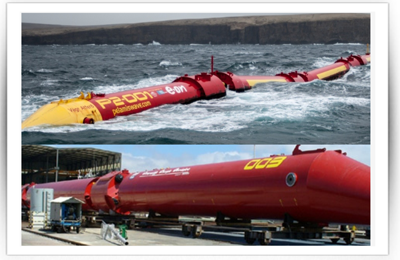| Founded in 1998, Pelamis Wave Energy Converter uses a technology that used the motion of ocean surface waves to create electricity. The machine was made up of connected sections which flex and bend as waves pass; it is this motion which is used to generate electricity. Developed by the now defunct Scottish company Pelamis Wave Power (formerly Ocean Power Delivery), the Pelamis became the first offshore wave machine to generate electricity into the grid, when it was first connected to the UK grid in 2004.
Wave energy research was pioneered by "Salter's Duck", developed by Professor Stephen Salter of the University of Edinburgh. With an efficiency of around 90%, the duck moves up and down with the waves. The Pelamis is cylindrical, with four main tube segments linked by hinged joints. Each segment measures 120m long and 3.5m wide, and weighs 750 tons when fully ballasted. The machine operates semi-submerged, extracting power from the wave-induced motion of the hinged joints. This power is resisted by hydraulic rams, which pump high-pressure oil through smoothing accumulators to hydraulic motors. Each module contains a complete electro-hydraulic power generation system, with a single seabed cable linking several devices to the shore. The machine is held in position by a mooring system combining floats and weights that prevent the mooring cables from becoming taut.This maintains enough restraint to keep the Pelamis positioned but allows the machine to swing head on to oncoming waves. |
The Pelamis is ideally moored in waters around 50–60m deep (often 5–10km from the shore). This gives access to large swell waves but avoids the costs of a longer submarine cable.
Wave power is perhaps Portugal's most promising form of renewable energy. Large, powerful waves come in from the Atlantic over a long coastline. Estimates predict that wave power could make up to 30% of the country's gross domestic product by 2050. Wave also has the potential to become one of the lowest cost forms of electricity generation, with opening costs now around half those of wind energy and a quarter those of solar PV.
Source: https://www.power-technology.com/projects/pelamis/
 *Image source: http://www.emec.org.uk/about-us/wave-clients/pelamis-wave-power/
*Image source: http://www.emec.org.uk/about-us/wave-clients/pelamis-wave-power/
|